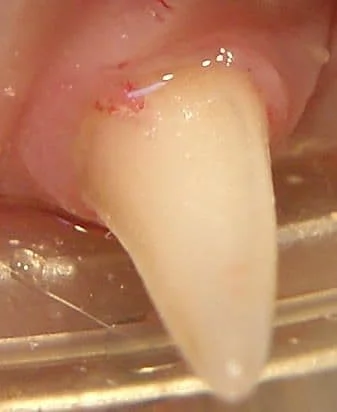Carious lesions or “cavities” similar to those seen in humans are uncommon, but they do occur.
Dogs are affected by true caries more than cats, and the most common place to find them are on the occlusal surface of the molars. True cavities are caused by the acid produced after digestion of carbohydrates by certain bacteria. The shape of the teeth, pH of saliva, normal bacteria inhabitants, and diet have all been suggested as reasons dogs and cats are less likely to develop cavities.
If caught early, these can be cleaned out and a filling placed to maintain the tooth. If the cavity extends near or into the pulp canal, root canal therapy might be indicated if the owner wishes to save the tooth. In cases where there is extensive damage to the remaining tooth, extraction or resection of the damaged area and root canal therapy in the remaining tooth is indicated.

This is a carious lesion, “cavity”, in the upper left 1 st molar of a dog.

This is a painful dental resorptive lesion in a cat’s upper canine tooth.
Resorptive lesions: Although these can be seen in the dog, they are much more prevalent in the cat population. Most studies agree that on average, about 50% of domestic cats have at least one resorptive lesion.
Due to the destruction of the protective enamel that covers the surface of the tooth, these lesions can be very sensitive to those affected. Several theories have been proposed for the cause of these lesions, but to date, none has been proven. We do believe the incidence has increased over the past 100 years. Unless caught early, most of the teeth affected by resorptive lesions are best extracted.
Very early lesions may benefit from glass ionomer restoration, but in most cases, the restorations are lost and the lesion progresses within 18 months.
Dental radiographs are essential for proper treatment planning. In general, when extracting teeth with resorptive lesions, it is always best to remove the entire tooth root, but in cases where the roots are resorbing, no evidence of periapical or periodontal disease exists, stomatitis is not present, and in the event a root fractures, this root should continue the resorption process if left as is and the gingiva sutured over the extraction site.
'The Pet Dentist' - Location, Map, Directions. Offices serving greater Tampa Bay, Clearwater, St Petersburg, Brandon & Bradenton :






